Are you a Quiet Speculation member?
If not, now is a perfect time to join up! Our powerful tools, breaking-news analysis, and exclusive Discord channel will make sure you stay up to date and ahead of the curve.
As a lover of aggro-control and specifically thresh decks in Modern, which I consider the removal spell format, my focus when it comes to building decks of this type has always been on threats. Putting together a new brew? I first ask myself which threats to include. Glossing over recent decklists? My eyes first go to the creatures section, and then to the others if my interest is piqued. I think each aggro-control strategy can have its list essentially filled out quite easily once a threat suite is established.
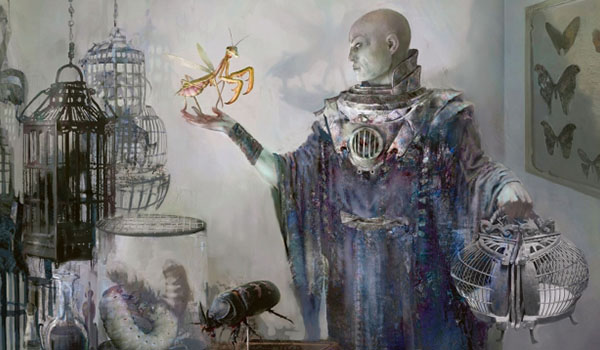
Last year, we saw aggro-control and aggro-combo shift its lens from the creature- and graveyard-oriented strategies of formats past to the instant/sorcery-based styles I've always preferred. Today's article looks at the threats prevalent in these decks and discusses where they're likeliest to end up in 2019.
Arclight Phoenix
We'll start with the breakout creature of 2018: Arclight Phoenix. This recurring bird has found its way into many an aggro-combo deck, as well as aggro-control hybrids featuring Thing in the Ice or Crackling Drake.
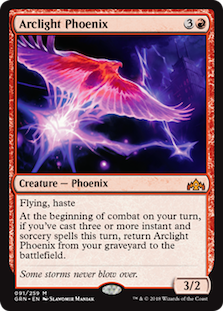 Phoenix's strength lies not in its on-paper grinding abilities, although those do give the card some added utility. Rather, Phoenix is generally employed as a hasty Insectile Aberration cheated into play on turn four or earlier, and always after pilots have steadily built towards another gameplan (i.e. casting Hollow One) or significantly disrupted opponents (i.e. with inexpensive red removal).
Phoenix's strength lies not in its on-paper grinding abilities, although those do give the card some added utility. Rather, Phoenix is generally employed as a hasty Insectile Aberration cheated into play on turn four or earlier, and always after pilots have steadily built towards another gameplan (i.e. casting Hollow One) or significantly disrupted opponents (i.e. with inexpensive red removal).
I find Phoenix's place in Modern particularly exciting going into the new year because it's currently in a huge variety of decks, and run alongside an equally diverse suite of creatures. Its preferred shells slide freely across the aggressiveness spectrum. A younger me may have assessed this predicament as par for the course in Modern, a "play-anything" format. But as its spotlight has grown, Modern has changed, becoming less friendly to fringe archetypes and solidified around the most robust, complete ways to do a given thing. As such, I think it's a matter of time before the "correct" Phoenix shell is found, and I think 2019 will see it emerge.
Thing in the Ice
While Phoenix's "true" home is still up in the air, I think Thing in the Ice's has already been found—and, unsurprisingly, it's alongside Arclight Phoenix.
UR Phoenix, by WHITE TSAR (1st, Modern Premier #11747383)
UR Phoenix looks to the blue splash chiefly for Thing in the Ice, which both provides the deck another undercosted threat relying on instants and sorceries that occurs at a different point on the strategic curve. Thing simultaneously does a lot for the deck's space, lightening the burden when it comes to the many removal spells demanded by creature-swarm decks like Spirits, Humans, or Company; a single flipped Thing sends all those pesky creatures back to the hand and close out the game before tribal players can rebuild. Those deckbuilding slots can then be spent on other cards, namely cantrips, which enable the deck's creatures and improve its consistency.
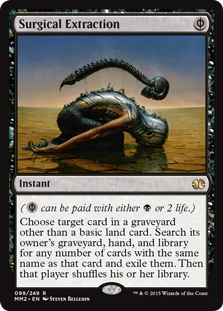 Thing in the Ice does still appear in other decks, but in far fewer numbers. By my analysis, those strategies succeed less than UR Phoenix because they are worse homes. But I can see something like Blue Moon (starring Thing and without Phoenix) to become a solid metagame call sometime next year, when the ideal Phoenix shell is found and players begin to modify their sideboards and deck choices more permanently to deal with the bird. Cards like Surgical Extraction may wind up more widely used than ones like Damping Sphere or Chalice of the Void, making Thing a safer bet for dealing damage in Izzet colors. That said, I don't expect Thing to ever divorce itself from red; Lightning Bolt and Manamorphose are friends too good for the Horror to leave behind.
Thing in the Ice does still appear in other decks, but in far fewer numbers. By my analysis, those strategies succeed less than UR Phoenix because they are worse homes. But I can see something like Blue Moon (starring Thing and without Phoenix) to become a solid metagame call sometime next year, when the ideal Phoenix shell is found and players begin to modify their sideboards and deck choices more permanently to deal with the bird. Cards like Surgical Extraction may wind up more widely used than ones like Damping Sphere or Chalice of the Void, making Thing a safer bet for dealing damage in Izzet colors. That said, I don't expect Thing to ever divorce itself from red; Lightning Bolt and Manamorphose are friends too good for the Horror to leave behind.
Bedlam Reveler
Unlike Arclight Phoenix and Thing in the Ice, Bedlam Reveler doesn't find itself confined to aggro-combo and tempo. It also appears in midrange shells such as Mardu Pyromancer. Of course, Mardu Pyromancer has all but vanished from the scene since Dredge and then Arclight Phoenix took the spotlight, as it suffers from splash grave hate and only intermittently has the right kind of interaction in hand for what the format throws at it. But the fact still stands that Reveler's proven itself to some degree as a midrange player.
The value of the card in those shells reflects what it actually does for decks that run it. Reveler cheaply refills pilots on cards after the game has progressed a certain amount. Cards like Manamorphose and Thought Scour accelerate the speed at which Reveler can be played; cards like Fatal Push and Thoughtseize slow the game down. The latter are more valuable when they impact the game, while the former demand mana investment but don't interact with the board.
 I see Reveler role in 2019 to be that of propping up the aggro-combo and aggro-control shells we've seen emerge since Arclight Phoenix emerged. Aggro-combo decks can use it to power through the disruption of midrange and other attrition strategies, while aggro-control wants to use Reveler to get ahead of other controlling decks. In both cases, the card is weak against highly proactive strategies, so Reveler is likely to sit on the sidelines in metagames heavy on those. It's also got some stiff competition in other colors, including in blue, the color most often paired with the Devil—Chart a Course, Snapcaster Mage, and Crackling Drake all generate card advantage as well. So I think Reveler is likely to make the biggest impact in mono-red decks.
I see Reveler role in 2019 to be that of propping up the aggro-combo and aggro-control shells we've seen emerge since Arclight Phoenix emerged. Aggro-combo decks can use it to power through the disruption of midrange and other attrition strategies, while aggro-control wants to use Reveler to get ahead of other controlling decks. In both cases, the card is weak against highly proactive strategies, so Reveler is likely to sit on the sidelines in metagames heavy on those. It's also got some stiff competition in other colors, including in blue, the color most often paired with the Devil—Chart a Course, Snapcaster Mage, and Crackling Drake all generate card advantage as well. So I think Reveler is likely to make the biggest impact in mono-red decks.
Delver of Secrets
Of the creatures discussed so far, I think Reveler has the bleakest prospects for 2019. Notice how I said "so far." It's not that I think Delver of Secrets is bad—and not like that thought has ever stopped me from believing in the card before anyway. Rather, Delver's issues in Modern are twofold.
The Delver Meta
First, Delver requires a certain metagame to thrive. Its pilots want to deploy threats early and then interact with opponents while attacking them each turn until a 3/2 gets them dead. For that scenario to play out, the following conditions must be fulfilled:
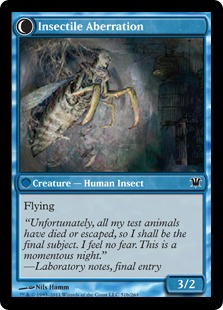 Games must last around six turns, already a big ask in Modern
Games must last around six turns, already a big ask in Modern- Opponents must play hardly any removal, as most removal spells remove a one-mana 3/2
- Matchups must exist (and in large quantities) in which pilots are rewarding for sticking a cheap threat early and interacting for a few turns while clocking
Only a few decks even check the box for the final point: Ironworks, Tron, and Storm are the big examples. But Modern is so vast that Delver decks must have a Plan B for the rest of the field. And a Plan C. And a Plan D. The thresh strategy is also plenty weak to top-performing archetypes like all-in aggro and midrange, and even the combo decks in Modern pack tons of removal. All these factors combine to make winning with Delver of Secrets a seriously optimistic resolution for the new year.
The Delver Card Pool
Second, Delver lacks the supporting cast it needs to excel in Modern. Players have long bemoaned the absence of Brainstorm, a card that sets up the insect quite well on paper. In practice, though, Legacy Delver decks rarely used Brainstorm to flip their creatures, instead waiting until the optimal time to Brainstorm for value and flipping Delver by virtue of running decks full of instants and sorceries.
That's not something we have the luxury of in Modern, as hinging on a 3/2 requires pilots to run lots more creatures. Some of those creatures, like Tarmogoyf and delve threats, further tax deck composition by asking for stuff like Mishra's Bauble to be playable themselves.
 And when it comes to cantrips, Ponder is really HBIC for transforming the Human. We don't have that card, either. Fetchlands plus shocks mean we take tons of damage from our lands and are therefore soft to many aggro decks in addition to removal-spell decks. More directly, the loss of consistency from cantrips contributes to Delver's "answer problem," where the deck must find the right pieces of interaction (and the right mix of threats) at the right time to stand a chance against whatever the opponent's doing, which tends to be quite streamlined and effective in this format. Preordain would go a long way towards improving this scenario for Delver, as would more flexible answers à la Lightning Bolt.
And when it comes to cantrips, Ponder is really HBIC for transforming the Human. We don't have that card, either. Fetchlands plus shocks mean we take tons of damage from our lands and are therefore soft to many aggro decks in addition to removal-spell decks. More directly, the loss of consistency from cantrips contributes to Delver's "answer problem," where the deck must find the right pieces of interaction (and the right mix of threats) at the right time to stand a chance against whatever the opponent's doing, which tends to be quite streamlined and effective in this format. Preordain would go a long way towards improving this scenario for Delver, as would more flexible answers à la Lightning Bolt.
The other problem with Delver's available cards is that of threats. Sure, this entire article's been about threats, but those mentioned don't always work well with the Insect. Arclight asks pilots to cast many instants and sorceries on their own turn, leaving no mana up for permission with which to protect Delver and execute its primary gameplan. Thing in the Ice asks something similar, but is even slower than Phoenix; still, it's better than the bird.
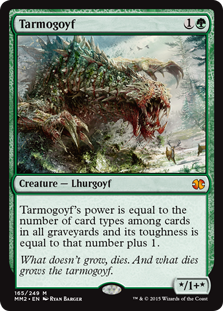 Tarmogoyf also asks two mana, although in return it impacts the board immediately. That's still the threat I've opted for most of the time; green also gives us Hooting Mandrills, a fine addition to Delver decks. Bedlam Reveler uses the same space as those two threats, and does significantly more work than Goyf in a Fatal Push format. But its cost complicates splashing green and running delve cards. Still, I've run them all in the same 75, but without Gitaxian Probe I don't think that's possible anymore.
Tarmogoyf also asks two mana, although in return it impacts the board immediately. That's still the threat I've opted for most of the time; green also gives us Hooting Mandrills, a fine addition to Delver decks. Bedlam Reveler uses the same space as those two threats, and does significantly more work than Goyf in a Fatal Push format. But its cost complicates splashing green and running delve cards. Still, I've run them all in the same 75, but without Gitaxian Probe I don't think that's possible anymore.
I am a little interested in Reveler's applications alongside Delver in a greenless shell. The deck would have to play permission, the only reason to include Delver over the more forgiving Phoenix and Thing, and would likely benefit from either Manamorphose or Thought Scour for help with Reveler. I don't really like either of those cantrips, though—Scour costs mana and doesn't impact the board, while Manamorphose plays poorly with counterspells. On the bright side, Snapcaster Mage does lightens the load when it comes to filling out the threat suite, as it plays well in a more reactive Delver-style shell.
Other Options
The other instant/sorcery-powered creatures in Modern are mostly used as role-players in shells defined by one of the aforementioned threats. We'll review them here.
Young Pyromancer
Punishes opponents for not having damage-based sweepers, but nearly every red deck now runs those in some capacity. Pyromancer is also quite squishy, dying to just about everything including the now commonly-played Gut Shot. Thing is often a better option in decks that might want Pyromancer, as it's sturdier and fills more roles.
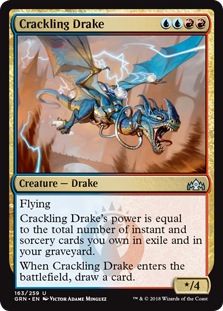 Crackling Drake
Crackling Drake
A curve-topper for these decks that helps in attrition matchups and closes games out against removal spell decks in general. Too pricey (both in terms of CMC and color requirements) to be easily splashable or run in large numbers.
Monastery Swiftspear
As it doesn't use the graveyard at all, Monastery Swiftspear is an attractive compliment for instant/sorcery-based aggro decks looking to up their aggression factor. But it requires a host of specific cards to work, especially free prowess triggers. Manamorphose and Mishra's Bauble are the main benefiters here, as are direct-damage burn spells like Lava Spike. Swiftspear is also a lackluster topdeck in attrition situations, so it doesn't have much utility all through a game. Lately, we've seen the card enter spell-based aggro decks in smaller numbers, as in the above UR Phoenix decklist.
Casting a Spell Over the New Year
Which instant/sorcery creatures will reign supreme over 2019? My vote (and probably yours) goes to Arclight Phoenix, but I'm excited to see where that card settles, and how the other candidates then slot into the metagame. Delver of Secrets has me particularly excited, as that shell requires the smallest amount of dedicated enablers—it just lacks a proper payoff at the moment. As always, let me know your thoughts in the comments, and happy new year!




Hope to hear your thoughts on the new “simic” one drop flier (not sure of name, salamander drake is the creature type) that can adapt for 7U, reduced by #of instants and sorceries in the yard. Could it be delver 5-8? Does delver even want that, and if so in what colors? By what turn ought it reliably adapt?
That’s coming!